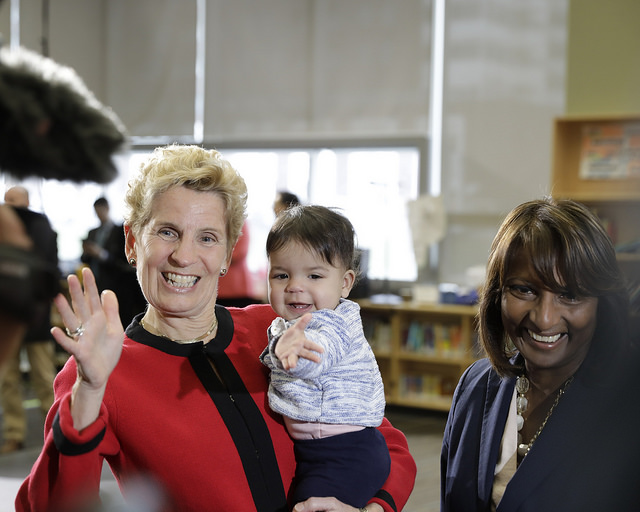
Ontario jumps back into the red as Liberals go on spending spree ahead of election
by Armina Ligaya, The Canadian Press

The province's books were balanced for the first time in a decade last year. A flurry of pre-election promises will push the government back into deficit. PC leader Doug Ford, meanwhile has promised to "restore fiscal responsibility"

A program promising free child care for preschoolers was among the last-minute additions to the budget. PHOTO: Premier of Ontario Photography/Flickr
TORONTO—Ontario’s debt is ballooning as the Liberal government takes the province back into deficit in its final budget before a spring election.
After bringing the books to balance last year for the first time in a decade, the province’s fiscal plan delivered March 28 projects a deficit of $6.7 billion in 2018-2019, followed by deficits of $6.6 billion and $6.5 billion in each of the subsequent years.
Ontario’s net debt, meanwhile, is projected to be $325 billion this year—or more than $22,500 per Ontarian—up from $308.2 billion expected as of March 31, 2018. The debt level is projected to grow to $360.1 billion by 2020-2021.
The Liberals’ decision to run a deficit reverses a key promise to stay in the black this year. The government had also previously projected the balance would extend to 2020. The province now anticipates its annual deficit will decrease gradually until 2024-2025.
The overall size of the budget, which pumps billions into health care, child care and other programs, has grown to $158.5 billion this year, up nearly 12 per cent from $141.1 billion last year.
Interest on debt remains the government’s fourth-largest spending area at $12.5 billion this year, and is projected to grow to $13.8 billion by 2020-21, and $16.9 billion by 2025-26.
Finance Minister Charles Sousa defended the province’s deficit and mounting debt, saying Ontario’s strong economy is what enables the government to afford increased spending.
He also said the government has built in a “tremendous amount of prudence and reserves” in its fiscal plan for any potential shocks to the system.
“I’m confident that as we move forward to invest in our economy, it will create greater growth, enabling us to have a stronger GDP and we’ll come to balance,” Sousa said.
But Progressive Conservative Leader Doug Ford lambasted the Liberal government’s planned deficits, saying taxpayers would end up “stuck with the bill.”
“Relief is on its way,” Ford said. “We will restore fiscal responsibility in Ontario.”
Ford stopped short, however, of saying a Tory government would balance the budget in its first year if it was to win power. He said his party needs to take a closer look at the provincial books, given that Ontario’s auditor general has previously criticized accounting practices used by the Liberal government.
Economists say there is little rationale for the provincial government to go back into deficit given the strength of the Ontario economy.
The unemployment rate was 5.5 per cent in February, one of the lowest jobless rates the province has seen. Meanwhile, Ontario’s economy has been strong, with estimated real GDP growth of 2.7 per cent in 2017. Real GDP growth is expected to slow to 2.2 per cent in 2018, and fall to 1.7 per cent by 2021.
Conference Board of Canada economist Craig Alexander said while there is some logic for programs in the budget such as free child care for preschoolers that will increase labour participation in the long run, the growing cost of servicing a larger debt cuts into spending on other priorities.
“When the unemployment rate is close to … full employment, there’s not much slack in the labour market, and the economy is delivering solid growth, there really isn’t a rationale for running deficits. At least not an economic rationale,” Alexander said.
Going into deficit now and in the coming years restrains the government’s ability to take a hit when the economic cycle takes a turn, said Douglas Porter, chief economist with BMO Financial Group.
“Eventually we will hit heavier weather. And ideally you would like to see government finances in relatively strong shape when we hit that heavy weather,” he said.
The net-debt-to-GDP ratio is up to roughly 37.6 per cent this year, marking the first increase since it peaked in 2014-15 at 39.3 per cent.
Going forward, the provincial government forecasts that the net-debt-to-GDP ratio will stay below the 2014-15 peak, but not resume a downward trend until 2022-23.
In last year’s budget, the provincial government said it hoped to lower the net-debt-to-GDP ratio to pre-recession levels of 27 per cent by 2029-30, and set a target of reducing that number to 35 per cent by 2023-24. Those targets no longer appear in the latest budget, and the province is projecting a net-debt-to-GDP ratio of 35.5 per cent by 2025-26.